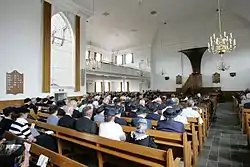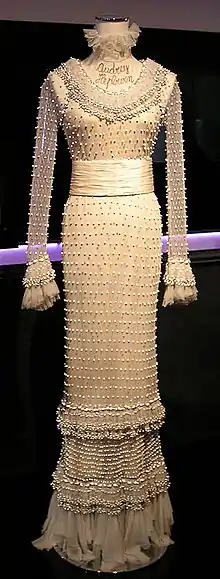Christian clothing
Many Christians have followed certain dress codes during attendance at church. Customs have varied over time and among different Christian denominations.
| Part of a series on |
| Christianity |
|---|
|
Clothing worn during religious services

In some Christian communities, the term "Sunday best" refers to the tradition of saving one's finest clothing for Sunday services. In some communities, churches served as the main social center for local residents. As such, dressing in fine clothing for religious services was often dictated by a need to project status and influence among peers.[1] Many Christians reject this practice and instead encourage modest, respectful dress not only for Sunday worship, but in everyday life (cf. outward holiness).[2] For example, Methodists in the conservative holiness movement teach with respect to modesty that before the fall of man, "Nakedness was 'very good' from the beginning, but its innocence was corrupted by the fall", a concept taught in Genesis 1:31 and Genesis 2:25.[3] Genesis 3:8–10 and Revelation 16:15 teach that after the fall of man, "publicly exposed nakedness is a symbol of the shame of sin."[3] In Genesis 3:7, Adam and Eve tried to cover their nakedness, though their attempt was inadequate for God; this, according to Holiness Methodist theology, reflects the tendency in humans to "invent inadequate coverings for our nakedness."[3] Genesis 3:21 and Revelation 3:18 teach that Jehovah properly clothed humans and that a "fully-clothed person is a God-ordained symbol of the full clothing of Christ's righteousness."[3] Exodus 20:26 and Exodus 28:42–43 teach that nakedness is inclusive of anything that includes the torso and thighs; as such Christians of the Holiness Methodist tradition wear pants or dresses that go beyond the knees, as well as shirts that do not expose the underarms.[3]
Many Christian traditions encourage or require adherents to don clothing of religious significance during church services, such as a headcovering, a practice enjoined by Paul in the Bible (1 Corinthians 11:2–6).[4][5][6] As such, headcoverings are often required of women attending services in many modern Anabaptist sects and some Reformed and Eastern Orthodox communities.[7][8] Some Catholic, Lutheran, Anglican, Methodist and non-denominational Christian women also choose to cover their heads for worship.[9][10] Some Christian holy days incorporate traditional clothing, such as the Easter bonnet. Christians' clothing has, however, evolved over time.
In recent decades, some churches have encouraged a more informal dress code. Among the first to adopt this policy were the Calvary Chapel associated churches.[11] Many clergy members, especially those in denominations and religious groups formed in the 20th century, have abandoned the traditional robes and vestments in favor of business casual clothing. This change was made to close the perceived gap between the clergy and laypersons. Some even wear jeans and other everyday casual wear if the members have chosen to dress casual as well. Though a small minority, Christian naturists take this one step further, and wear no clothing at all, which they see as "God's design".
See also
- Religious clothing – including further information on Christian religious clothing
References
- "The Origin of Dressing Up for Church". 8 December 2014.
- "What Should We Wear to Worship?", Radically Christian, 27 May 2015.
- Arnold, Johnathan (21 January 2022). "A Simple Outline for Teaching on Modest Clothing". Holy Joys. Retrieved 24 January 2022.
- Bercot, David W. (1992). Common Sense: A New Approach to Understanding Scripture. Scroll Publishing Co. p. 68. ISBN 978-0-924722-06-6.
Hippolytus, a leader in the church in Rome around the year 200, compiled a record of the various customs and practices in that church from the generations that preceded him. His Apostolic Tradition contains this statement: "And let all the women have their heads covered with an opaque cloth, not with a veil of thin linen, for this is not a true covering." This written evidence of the course of performance of the early Christians is corroborated by the archaeological record. The pictures we have from the second and third centuries from the catacombs and other places depict Christian women praying with a cloth veil on their heads. So the historical record is crystal clear. It reveals that the early generation of believers understood the head covering to be a cloth veil—not long hair.
- "Veil". Early Christian Dictionary. Retrieved 7 September 2021.
- Earle, Alice Morse (1903). Two Centuries of Costume in America, Vol. 2 (1620–1820). The Macmillan Company. p. 582.
One singular thing may be noted in this history, – that with all the vagaries of fashion, woman has never violated the Biblical law that bade her cover her head. She has never gone to church services bareheaded.
- "Uncovering the Head Covering Debate". Her.meneutics. Retrieved 2016-03-08.
- Murray, John (15 January 1992). "The Use of Head Coverings in the Worship of God". Presbyterian Reformed Church. Retrieved 22 November 2021.
- Bailey, Mark (2003). Nelson's New Testament Survey: Discovering the Essence, Background & Meaning About Every New Testament Book. Thomas Nelson Inc. ISBN 9781418540876.
- Witness Lee (August 1990). Life-Study of 1 Corinthians: Messages 48-69, 3. pp. 470–471. ISBN 9780870831423.
- "Calvary Chapel Core Convictions: Informal/ Relaxed Style". Archived from the original on 2016-03-08. Retrieved 2016-03-08.
External links
- “Modern Christian Clothing” May 27, 2021
- "A Business of the Cloth Finds a Surge in Demand" by Debra Nussbaum, "The New York Times", January 28, 1996, retrieved September 6, 2009.
- Contemporary Christian Clothing Brands
- "What Would Jesus Sell?" by Stephanie Simon, "The Los Angeles Times", July 21, 2006, retrieved January 4, 2010.

